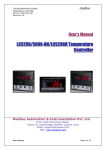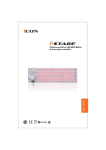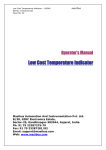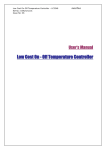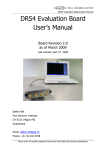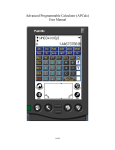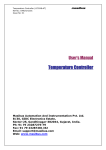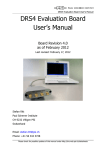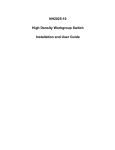Download 1 User`s Manual for the DLL version of ORGANON 9.1 The
Transcript
User's Manual for the DLL version of ORGANON 9.1
The ORGRUN.DLL and ORGRUN.LIB Microsoft compatible import
files were created using the Lahey/Fujitsu FORTRAN 95 compiler.
Two subroutines have been exposed for usage by other programs:
EXECUTE and GET_ORGRUN_EDITION
SUBROUTINE EXECUTE(CYCLG,VERSION,NPTS,NTREES1,STAGE,BHAGE,TREENO,
PTNO,SPECIES,USER,INDS,DBH1,HT1,CR1,SCR1,
EXPAN1,MGEXP,RVARS,ACALIB,PN,YSF,BABT,BART,
YST,NPR,PRAGE,PRLH,PRDBH,PRHT,PRCR,PREXP,
BRCNT,BRHT,BRDIA,JCORE,SERROR,TERROR,SWARNING,
TWARNING,IERROR,DGRO,HGRO,CRCHNG,SCRCHNG,
MORTEXP,NTREES2,DBH2,HT2,CR2,SCR2,EXPAN2,STOR)
DIMENSIONS TREENO(2000),PTNO(2000),SPECIES(2000),USER(2000),
INDS(30),DBH1(2000),HT1(2000),CR1(2000),SCR1(2000),
EXPAN1(2000),MGEXP(2000),RVARS(30),ACALIB(3,18),
PN(5),YSF(5),BART(5),YST(5),NPR(2000),PRAGE(2000,3),
PRLH(2000,3),PRDBH(2000,3),PRHT(2000,3),PRCR(2000,3),
PREXP(2000,3),BRCNT(2000,3),BRHT(2000,40),
BRDIA(2000,40),JCORE(2000,40),SERROR(35),
TERROR(2000,6),SWARNING(9),TWARNING(2000),DGRO(2000),
HGRO(2000),CRCHNG(2000),SCRCHNG(2000),MORTEXP(2000),
NTREES2,DBH2(2000),HT2(2000),CR2(2000),SCR2(2000),
EXPAN2(2000),STOR(30)
The following variables will include a classification describing
whether each variable is strictly an “INPUT” variable (i.e., it
is entered into the DLL and is not modified by the DLL), strictly
an “OUTPUT” variable (i.e., it is created with in the DLL and
then outputted by the DLL), or a combination “INPUT/OUTPUT”
variable (i.e., it is entered into the DLL, modified by the DLL,
and the modified variable is outputted by the DLL).
Description of Variables
CYCLG
INTEGER*4
Total number of five-year growth
cycles previously grown in ORGANON.
(INPUT/OUTPUT variable)
VERSION
INTEGER*4
Version of ORGANON to be used: 1 =
Southwest Oregon (SWO), 2 =
Northwest Oregon (NWO), 3 = Stand
Management Cooperative (SMC), 4 =
Red Alder Plantation (RAP). (INPUT
variable)
1
NPTS
INTEGER*4
Total number of sample plots/points
used to collect the tree list data.
Include all treeless plots/points
in the count.(INPUT variable)
NTREES1
INTEGER*4
Total number of sample trees
measured in the stand at the start
of the growth period (NTREES1
cannot exceed 2000). The total
number of sample trees in the stand
would increase over the run if
tripling or ingrowth is used.
(INPUT/OUTPUT variable)
STAGE
INTEGER*4
Total stand age at the start of the
current growth cycle(s). ORGANON
will update this value during
projections. STAGE should be 0 for
an uneven-aged stand. (INPUT/OUTPUT
variable)
BHAGE
INTEGER*4
Breast height stand age at the
start of the current growth
cycle(s). ORGANON will update this
value during projections. BHAGE
should be 0 for an uneven-aged
stand. (INPUT/OUTPUT variable)
TREENO(I)
INTEGER*4
Tree number for the Ith sample
tree, 1 I NTREES1 (maximum of
2000) at the start of the growth
period and 1 I NTREES2 at the
end of the growth period. (INPUT
variable)
PTNO(I)
INTEGER*4
Point number for the Ith sample
tree, 1 I NTREES1 (maximum of
2000) at the start of the growth
period and 1 I NTREES2 at the
end of the growth period. (INPUT
variable)
SPECIES(I)
INTEGER*4
Species code for the Ith sample
tree, 1 I NTREES1 (maximum of
2000) at the start of the growth
period and 1 I NTREES2 at the
end of the growth period. (INPUT
variable)
2
USER(I)
INTEGER*4
User code for the Ith sample tree,
1 I NTREES1 (maximum of 2000)
at the start of the growth period
and 1 I NTREES2 at the end of
the growth period. (INPUT variable)
INDS(1)
INTEGER*4
1 = Use height/DBH calibration
factors for the projection; 0 = Do
not use height/DBH calibration
factors for the projection. (INPUT
variable)
INDS(2)
INTEGER*4
1 = Use crown ratio calibration
factors for the projection; 0 = Do
not use crown ratio calibration
factors for the projection. (INPUT
variable)
INDS(3)
INTEGER*4
1 = Use diameter growth rate
calibration factors for the
projection; 0 = Do not use diameter
growth rate ratio calibration
factors for the projection. (INPUT
variable)
INDS(4)
INTEGER*4
1 = Stand is even-aged; 0 = Stand
is uneven-aged. (INPUT variable)
INDS(5)
INTEGER*4
1 = Triple the sample tree list
during projection (if possible); 0
= Do not triple the sample tree
list during projection. Tripling
will continue until a maximum of
2000 sample trees is achieved.
NTREES2 will be larger than NTREES1
if tripling is selected and if it
can be applied to the run (because
NTREES1 is small enough).(INPUT
variable)
INDS(6)
INTEGER*4
1 = Stand has been pruned either at
the start of this growth cycle(s)
or in the past; 0 = Stand has never
been pruned. (INPUT variable)
INDS(7)
INTEGER*4
1 = Stand has been partially cut
either at the start of this growth
cycle(s) or in the past; 0 = Stand
has never been partially cut.
(INPUT variable)
3
INDS(8)
INTEGER*4
1 = Stand has been fertilized
either at the start of this growth
cycle(s) or in the past; 0 = Stand
has never been fertilized. (INPUT
variable)
INDS(9)
INTEGER*4
1 = Use limit of maximum SDI; 0 =
Do not use limit of maximum SDI.
(INPUT variable)
INDS(10)
INTEGER*4
1 = Wood quality variables are
being computed; 0 = Wood quality
variables are not being computed.
(INPUT variable)
INDS(11)
INTEGER*4
1 = Overstory trees were removed at
the start of the current growth
cycle; 0 = Overstory trees were not
removed at the start of the current
growth cycle. (INPUT variable)
INDS(12)
INTEGER*4
1 = Ingrowth was added at the start
of the current growth cycle; 0 =
Ingrowth was not added at the start
of the current growth cycle. (INPUT
variable)
INDS(13)
INTEGER*4
1 = Major conifer trees were cut at
the start of the current growth
cycle; 0 = Major conifer trees were
not cut at the start of the current
growth cycle. For the southwest
Oregon version of ORGANON, major
conifer species are Douglas-fir,
white fir, grand fir, ponderosa
pine, sugar pine, and incensecedar. For the northwest Oregon and
Stand Management Cooperative
versions of ORGANON, major conifer
species are Douglas-fir, grand fir,
and western hemlock. (INPUT
variable)
INDS(14)
INTEGER*4
1 = The even-aged stand has been
planted with genetically improved
Douglas-fir; 0 = The even-aged
stand was not planted with
genetically improved Douglas-fir.
(INPUT variable)
4
INDS(15)
INTEGER*4
1 = The Douglas-fir in the stand
have been infected with Swiss
needle cast; 0 = The Douglas-fir in
the stand have not been infected
with Swiss needle cast. Only
applicable to the NWO and SMC
versions of ORGANON. (INPUT
variable)
INDS(16+)
INTEGER*4
Currently not used, set to 0.
(INPUT variable)
DBH1(I)
REAL*4
DBH for the Ith sample tree at the
start of the growth period, 1 I
NTREES1 (maximum of 2000). (INPUT
variable)
HT1(I)
REAL*4
Total height for the Ith sample
tree at the start of the growth
period, 1 I NTREES1 (maximum of
2000). (INPUT variable)
CR1(I)
REAL*4
Crown ratio for the Ith sample tree
at the start of the growth period,
1 I NTREES1 (maximum of 2000)
(INPUT variable).
SCR1(I)
REAL*4
Shadow crown ratio for the Ith
sample tree at the start of the
growth period, 1 I NTREES1
(maximum of 2000). Shadow crown
ratio is used for pruned trees and
it is the crown ratio of the tree
if it had not been pruned. ORGANON
will update shadow crown ratios.
Therefore, it is strongly
recommended that stands which had
been pruned before the measurement
of the input tree listing not be
projected in ORGANON. For unpruned
stands, set SCR1 to zero. For the
first pruning conducted in ORGANON,
set SCR1 for each pruned tree to
the CR before pruning. For a
subsequent pruning in ORGANON, set
SCR1 for each newly pruned tree to
either the CR before the subsequent
pruning or to the previous SCR
value, whichever is larger. (INPUT
variable)
5
EXPAN1(I)
REAL*4
The plot/point level expansion
factor for the Ith sample tree at
the start of the growth period
(i.e., the expansion factors should
NOT be divided by the total number
of plots/points measured in the
stand), 1 I NTREES1 (maximum of
2000). (INPUT variable)
MGEXP(I)
REAL*4
The plot/point level expansion
factor for the Ith sample tree at
the start of the growth period that
was removed by cutting just prior
to the start of the current growth
period (i.e., do not include trees
cut at the start of previous growth
periods), 1 I NTREES1 (maximum
of 2000) at the start of the growth
period and 1 I NTREES2 at the
end of the growth period. Again,
the expansion factors should NOT be
divided by the total number of
plots/points measured in the stand.
(INPUT variable)
RVARS(1)
REAL*4
The value of SITE_1: Douglas-fir
site index: Hann and Scriviani
(1987) for the SWO version, and
Bruce (1981) for the NWO and SMC.
Red alder site index: Weiskittel et
al. (2009) for the RAP version. For
the SWO, NWO, and SMC versions,
ORGANON will calculate this value
from SITE_2 if it is set to zero.
For the RAP version, SITE_1 must be
entered. (INPUT variable)
RVARS(2)
REAL*4
Other site index (SITE_2): Hann and
Scriviani (1987) ponderosa pine
site index for the SWO version and
Flewelling's site index for western
hemlock in the NWO and SMC
versions. For the RAP version,
Bruce (1981) Douglas-fir site
index. For the SWO, NWO, and SMC
versions, ORGANON will calculate
this value from SITE_1 if it is set
to zero. For the RAP version, it
will be reset to 115 if not entered
by the user. (INPUT variable)
6
RVARS(3)
REAL*4
Maximum stand density index of
Douglas-fir for the SWO, NWO, and
SMC versions. Maximum stand density
index of red alder for the RAP
version. A value of 0 will result
in the version specific default
value being used. (INPUT variable)
RVARS(4)
REAL*4
Maximum stand density index of
white fir and/or grand fir for the
SWO, NWO, and SMC versions. Maximum
stand density index of Douglas-fir
for the RAP version. A value of 0
will result in the version specific
default value being used. (INPUT
variable)
RVARS(5)
REAL*4
Maximum stand density index of
ponderosa pine for the SWO version
and western hemlock in the NWO,
SMC, and RAP versions. A value of 0
will result in the version specific
default value being used. (INPUT
variable)
RVARS(6)
REAL*4
Douglas-fir genetic worth value for
diameter growth rate. Only
applicable to even-aged stands.
(INPUT variable)
RVARS(7)
REAL*4
Douglas-fir genetic worth value for
height growth rate. Only applicable
to even-aged stands. (INPUT
variable)
RVARS(8)
REAL*4
Douglas-fir foliage retention as a
result of infection by Swiss needle
cast. Only applicable to the NWO
and SMC versions of ORGANON. (INPUT
variable)
RVARS(9)
REAL*4
For RAP-ORGANON, the starting
number of red alder trees per acre
(i.e., planting density) for the
plantation. Must be specified for
RAP-ORGANON only, otherwise it is
set to zero. (INPUT variable)
RVARS(10+)
REAL*4
Currently unused, set to 0. (INPUT
variable)
7
ACALIB(I,J)
REAL*4
Actual calibration values for the
Ith attribute (when I=1, the
height/DBH equation; I=2, the crown
ratio equation; and I=3, the
diameter growth rate equation); and
the Jth species group depending
upon the version of ORGANON, 1 J
18. Species groups are calculated
in the DLL based upon version and
species for the tree. (INPUT
variable)
PN(I)
REAL*4
Number of pounds of nitrogen
applied per acre at the Ith
application, 1 I 5. I=1 for the
most recent application, I=2 for
the next most recent application,
etc. PN must be 400. The whole
array should be set to 0 if no
fertilization has occurred. As an
example, a stand was fertilized
with 100 lbs. of nitrogen 7 years
before the stand was measured, a
second fertilization of 200 lbs. of
nitrogen was conducted at the start
of the run, and a third
fertilization of 300 lbs. of
nitrogen was conducted after two
growth cycles: PN(1)=300.0,
PN(2)=200.0, PN(3)=100.0,
PN(4)=0.0, PN(5)=0.0. (INPUT
variable)
8
YSF(I)
REAL*4
Number of years since start of the
run that the Ith application of
nitrogen fertilizer was applied, 1
I 5. I=1 for the most recent
application, I=2 for the next most
recent application, etc. The whole
array should be set to 0.0 if no
fertilization has occurred. For
fertilizations conducted before the
stand was measured, YSF(I)=-(number
of years from the Ith fertilization
to when the stand was measured).
For fertilizations conducted in
ORGANON, YSF(I)=5(the value of
CYCLG at the time of
fertilization). As an example, a
stand was fertilized 7 years before
the stand was measured, a second
time at the start of the run, and a
third time after two growth cycles:
YSF(1)=10.0 (i.e., 5x2), YSF(2)=0.0
(i.e., 5x0), YSF(3)=-7.0,
YSF(4)=0.0, YSF(5)=0.0. (INPUT
variable)
BABT
REAL*4
Basal area per acre of the stand
just before the most recent removal
of trees. BABT should be set to 0.0
if no tree removal has occurred.
(INPUT variable)
BART(I)
REAL*4
Basal area per acre cut at the Ith
removal of trees, 1 I 5. I=1
for the most recent removal, I=2
for the next most recent removal,
etc. The whole array should be set
to 0 if no tree removal has
occurred. As an example, a stand
had 50.0 ft2 removed 7 years before
the stand was measured, a second
thinning removed 100.0 ft2 at the
start of the run, and a third
thinned removed 150.0 ft2 after two
growth cycles: BART(1)=150.0,
BART(2)=100.0, BART(3)=50.0,
BART(4)=0.0, BART(5)=0.0. (INPUT
variable)
9
YST(I)
REAL*4
Number of years since the start of
the run that the Ith removal of
trees occurred, 1 I 5. I=1 for
the most recent removal, I=2 for
the next most recent removal, etc.
The whole array should be set to
0.0 if no thinning has occurred.
For thinnings conducted before the
stand was measured, YST(I)=-(number
of years from the Ith thinning to
when the stand was measured). For
thinnings conducted in ORGANON,
YST(I)=5(the value of CYCLG at the
time of thinning). As an example, a
stand was thinned 7 years before
the stand was measured, a second
time at the start of the run, and a
third time after two growth cycles:
YST(1)=10.0 (i.e., 5x2), YST(2)=0.0
(i.e., 5x0), YST(3)=-7.0,
YST(4)=0.0, YST(5)=0.0. (INPUT
variable)
NPR(I)
INTEGER*4
Number of prunings conducted on the
Ith tree, 1 I NTREES1 (maximum
of 2000) at the start of the growth
period and 1 I NTREES2 at the
end of the growth period. A maximum
of three prunings are allowed on a
tree. (INPUT variable)
PRAGE(I,J)
INTEGER*4
Age of the Ith tree when the Jth
pruning was conducted on the tree,
1 I NTREES1 (maximum of 2000)
at the start of the growth period
and 1 I NTREES2 at the end of
the growth period, 1 J 3.
(INPUT variable)
PRLH(I,J)
REAL*4
Lift height, in feet, for the Ith
tree when the Jth pruning was
conducted on the tree, 1 I
NTREES1 (maximum of 2000) at the
start of the growth period and 1
I NTREES2 at the end of the
growth period, 1 J 3. (INPUT
variable)
10
PRDBH(I,J)
REAL*4
DBH of the Ith tree when the Jth
pruning was conducted on the tree,
1 I NTREES1 (maximum of 2000)
at the start of the growth period
and 1 I NTREES2 at the end of
the growth period, 1 J 3.
(INPUT variable)
PRHT(I,J)
REAL*4
Total height of the Ith tree when
the Jth pruning was conducted on
the tree, 1 I NTREES1 (maximum
of 2000) at the start of the growth
period and 1 I NTREES2 at the
end of the growth period, 1 J
3. (INPUT variable)
PRCR(I,J)
REAL*4
Crown ratio of the Ith tree when
the Jth pruning was conducted on
the tree, 1 I NTREES1 (maximum
of 2000) at the start of the growth
period and 1 I NTREES2 at the
end of the growth period, 1 J
3. (INPUT variable)
PREXP(I,J)
REAL*4
Plot/point level expansion factor
of the Ith tree when the Jth pruning
was conducted on the tree, 1 I
NTREES1 (maximum of 2000) at the
start of the growth period and 1
I NTREES2 at the end of the
growth period, 1 J 3. (INPUT
variable)
BRCNT(I,J)
INTEGER*4
Wood quality branch count of type J
for the Ith tree, 1 I NTREES1
(maximum of 2000) at the start of
the growth period and 1 I
NTREES2 at the end of the growth
period, 1 J 3. (INPUT variable)
BRHT(I,J)
INTEGER*4
Height to the Jth branch on the Ith
tree, 1 I NTREES1 (maximum of
2000) at the start of the growth
period and 1 I NTREES2 at the
end of the growth period, 1 J
40. (INPUT variable)
11
BRDIA(I,J)
INTEGER*4
Branch diameter of the Jth branch
on the Ith tree, 1 I NTREES1
(maximum of 2000) at the start of
the growth period and 1 I
NTREES2 at the end of the growth
period, 1 J 40. (INPUT
variable)
JCORE(I,J)
INTEGER*4
Diameter of the juvenile wood core
at the Jth branch on the Ith tree, 1
I NTREES1 (maximum of 2000) at
the start of the growth period and
1 I NTREES2 at the end of the
growth period, 1 J 40. (INPUT
variable)
SERROR(I)
INTEGER*4
If SERROR(I)=1 (1 I 35), then a
stand level error of type "I" has
occurred (a value of 0 indicated no
error). See the following tables
for a description of the particular
errors. (OUTPUT variable)
TERROR(I,J)
INTEGER*4
If TERROR(I,J)=1 (1 I NTREES1,
1 J 6), then a tree level error
of type "J" has occurred for the
Ith tree (a value of 0 indicated no
error). See the following tables
for a description of the particular
errors. (OUTPUT variable)
SWARNING(I)
INTEGER*4
If SWARNING(I)=1 (1 I 9), then
a stand level warning of type "I"
has occurred (a value of 0
indicated no error). See the
following tables for a description
of the particular warnings. (OUTPUT
variable)
TWARNING(I)
INTEGER*4
If TWARNING(I)=1 (1 I NTREES1),
then a tree warning has occurred
for the Ith tree (a value of 0
indicated no error). See the
following tables for a description
of the particular warnings. (OUTPUT
variable)
12
IERROR
INTEGER*4
If IERROR=1, then a stand or tree
level error has occurred and the
error must be corrected before
proceeding. (OUTPUT variable)
DGRO(I)
REAL*4
The 5-year diameter growth rate for
the Ith sample tree, 1 I
NTREES2 (maximum of 2000). (OUTPUT
variable)
HGRO(I)
REAL*4
The 5-year height growth rate for
the Ith sample tree, 1 I
NTREES2 (maximum of 2000). (OUTPUT
variable)
CRCHNG(I)
REAL*4
The 5-year change in crown ratio
for the Ith sample, 1 I NTREES2
(maximum of 2000). (OUTPUT
variable)
SCRCHNG(I)
REAL*4
The 5-year change in the shadow
crown ratio for the Ith sample
tree, 1 I NTREES2 (maximum of
2000). (OUTPUT variable)
MORTEXP(I)
REAL*4
The plot/point level expansion
factor for 5-year mortality on the
Ith sample tree, 1 I NTREES1 at
the start of the growth period and
1 I NTREES2 at the end of the
growth period (maximum of 2000).
The expansion factors have NOT been
divided by the total number of
plots/points measured in the stand
(OUTPUT variable)
NTREES2
INTEGER*4
Total number of sample trees
measured in the stand at the end of
the growth period (NTREES2 cannot
exceed 2000). NTREES2 would be
larger than NTREES1 if tripling or
ingrowth are used, otherwise it is
the same as NTREES1. (INPUT/OUTPUT
variable)
DBH2(I)
REAL*4
DBH for the Ith sample tree at the
end of the growth period, 1 I
NTREES2 (maximum of 2000). (INPUT
variable)
13
HT2(I)
REAL*4
Total height for the Ith sample
tree at the end of the growth
period, 1 I NTREES2 (maximum of
2000). (INPUT variable)
CR2(I)
REAL*4
Crown ratio for the Ith sample tree
at the end of the growth period, 1
I NTREES2 (maximum of 2000)
(INPUT variable).
SCR2(I)
REAL*4
Shadow crown ratio for the Ith
sample tree at the end of the
growth period, 1 I NTREES2
(maximum of 2000). See the
description of SCR1 for more
details. (INPUT variable)
EXPAN2(I)
REAL*4
The plot/point level expansion
factor for the Ith sample tree at
the end of the growth period (i.e.,
the expansion factors should NOT be
divided by the total number of
plots/points measured in the
stand), 1 I NTREES2 (maximum of
2000). (INPUT variable)
STOR(I)
REAL*4
An array of 30 internal variables
used by ORGANON which must not
change over multiple calls of the
ORGANON DLL. Initialize to zero
before the first call to the
ORGANON DLL. ORGANON will then
calculate these values when
CYCLG=0. The resulting values
should not be modified by the DLL
user in subsequent continued
projections of the tree list.
(OUTPUT variable)
SUBROUTINE GET_ORGRUN_EDITION(EDITION)
Description of Variable
EDITION
REAL*4
Edition of the ORGRUN DLL (OUTPUT
variable)
14
Descriptions of the SERROR(I) Array
I
___
Description of the Error
______________________________________________________
1
NTREES < 1 or NTREES > 2000
2
VERSION < 1 or VERSION > 4
3
NPTS < 1
4
Both SITE_1 and SITE_2 are set to 0
5
There are no major tree species for the VERSION
6
BHAGE has been set to 0 for an uneven-aged stand
7
BHAGE > 0 for an uneven-aged stand
8
STAGE is too small for the BHAGE
9
An uneven-aged stand cannot be fertilized
10
YSF and/or PN variables are not zero for an unfertilized
stand
11
The implied stand age of fertilization (based on YSF) must
be less than or equal to current stand age or less than or
equal to 70 years.
12
PN < 0 or PN > 400 lbs per acre.
13
BART(1) BABT
14
YST and/or BART variables are not zero for an uncut stand
15
For an even-aged stand, the implied stand age of cutting
(based on YST) must be less than or equal to current stand
age.
16
For multiple cuttings in which YST ≠ 0, BART 0
17
BABT < 0 for a stand with cuttings
18
Some MGEXP values must be > 0 in a stand that has been cut
at the start of the growth period
19
CYCLG < 0
20
ACALIB < 0.5 or ACALIB > 2.0
21
MSDI_1, MSDI_2, and/or MSDI_3 > 1000
22
Stand not even-aged so genetic gain cannot be applied
23
A genetic worth value cannot be < 0%
15
24
A genetic worth value must be 20%
25
A genetic worth value is > 0% when no genetic gain is
indicated
26
Swiss needle cast cannot be applied to this version of
ORGANON
27
Swiss needle cast cannot be applied to an unevenaged stand
28
Foliage retention cannot be < 0.85
29
Foliage retention cannot be > 7.0
30
Fertilization cannot be applied to a stand with foliage
retention < 3.0
31
Foliage retention is 0.85 when no Swiss needle cast impact
is indicated
32
SITE_1 is set to 0 for RAP-ORGANON
33
PDEN is set to zero for RAP-ORGANON
34
Stand must be even-aged for RAP-ORGANON
35
Stand must have at least 90% of basal area in red
alder for RAP-ORGANON
16
Descriptions of the TERROR(I,J) Array
J
___
Description of the Error
______________________________________________________
1
Illegal species code for the VERSION
2
DBH 0.0
3
HT 4.5
4
CR 0.0 or CR > 1.0
5
EXPAN < 0.0
6
SCR < 0.0 or SCR > 1.0
17
Descriptions of the SWARNING(I) Array
I
___
Description of the Error
______________________________________________________
1
SITE_1 is out of range for the VERSION
2
SITE_2 is out of range for the VERSION
3
Tree heights are too large for the site index value
4
BHAGE is too young for the VERSION
5
Amount of minor species is higher than recommended for
the VERSION
6
Number of sample trees is below recommended minimum
7
Majority of the input stand is over the upper age
recommended for the VERSION
8
Majority of the projected stand is now over the upper
age recommended for the VERSION
9
Number of cycles to be projected will make the
resulting stand older than that recommended for the
VERSION.
18
Descriptions of the TWARNING(I) Array
J
___
1
Description of the Error
______________________________________________________
HT to DBH ratio is too large for the species
19
Examples of Using the ORGRUN.DLL in LAHEY FORTRAN
The following three examples demonstrate how the EXECUTE
subroutine in the ORGRUN.DLL can be used to conduct various
management activities using the ORGRUN.DLL. These example runs
read data from and all ready created ORGANON INP file which does
not contain tree number data. Therefore, temporary tree numbers
are created for the examples (of course data can be entered in
other ways and “real” tree numbers can be used. The following is
a brief description of each example:
1. The stand is grown for one five-year growth cycle; the stand
is fertilized with 200 pounds per acre of nitrogen; the
stand is grown for two five-year growth cycles; the stand is
fertilized again with 200 pounds of nitrogen per acre; and
then the stand is grown for one more five-year growth cycle.
2. The stand is grown for one five-year growth cycle; all trees
with a DBH greater than 10.0-inches are removed; the stand
is grown for two five-year growth cycles; all hardwood trees
are removed; and then the stand is grown for one more fiveyear growth cycle.
3. The stand is grown for one five-year growth cycle; all
Douglas-fir trees are pruned to a crown ratio of 0.5 or a
maximum lift height of 16.0-feet, whichever is lower;, the
stand is grown for two five-year growth cycles; all Douglasfir trees are pruned to a crown ratio of 0.3 or a maximum
lift height of 32.0-feet, whichever is lower; and then the
stand is grown for one more five-year growth cycle.
20
Example #1
C
C
C
THIS VERSION OF TESTDLL IS AN EXAMPLE OF APPLYING FERTILIZER USING
THE EXECUTE SUBROUTINE IN THE ORGRUN.DLL
PROGRAM TESTDLL
C
IMPLICIT NONE
C
C
1
1
2
3
1
1
2
3
4
5
C
C
C
C
C
C
C
C
C
C
C
C
INTEGER*4
INTEGER*4
INTEGER*4
INTEGER*4
REAL*4
REAL*4
CHARACTER
CHARACTER
CHARACTER
LOGICAL
LOGICAL*2
LU10,LU20,L,LEN,IANS,IYN,I,J
NPTS,NTREES1,STAGE,BHAGE,BIG6,OTHER,MISS,NEST,VERSION,
EDITION,FTYPE(5),TDATAI(2000,3),PTNO(2000)
CYCLG,ISTAGE,IBHAGE,TREENO(2000),SPECIES(2000),
USER(2000),NPR(2000),PRAGE(2000,3),BRCNT(2000,3),
BRHT(2000,40),BRDIA(2000,40),JCORE(2000,40),SERROR(35),
TERROR(2000,6),SWARNING(9),TWARNING(2000)
INDS(30),IERROR,NTREES2
SITE_1,SITE_2,MSDI_1,MSDI_2,MSDI_3,ACALIB(3,18),BAF(5),
VALUE(5),TDATAR(2000,4),PGROWTH(2000)
DBH1(2000),HT1(2000),CR1(2000),EXPAN1(2000),SCR1(2000),
PN(5),YSF(5),BABT,BART(5),YST(5),PRLH(2000,3),
PRDBH(2000,3),PRHT(2000,3),PRCR(2000,3),PREXP(2000,3),
OLD,MGEXP(2000),DGRO(2000),HGRO(2000),CRCHNG(2000),
SCRCHNG(2000),MORTEXP(2000),STOR(30), DBH2(2000),
HT2(2000),CR2(2000),EXPAN2(2000),SCR2(2000),RVARS(30)
ANS1*1
DNAME*128,SNAME*128,ONAME*128
TITLE*20,TYPE*1(5)
HERE
EVEN,RAD
IMPORT THE EXECUTE SUBROUTINE FOR THE ORGRUN.DLL
DLL_IMPORT EXECUTE
IMPORT THE READDATA SUBROUTINE FROM THE READINP.DLL FOR
READING ORGANON .INP FILES
DLL_IMPORT READDATA
LU10=10
LU20=20
DETERMINE THE NAME OF THE ORGANON CREATED .INP FILE TO OPEN
10 WRITE(*,1000)
1000 FORMAT(' Enter tree file name [ NO extension (i.e., ',
1
'C:MYFILE) ]',/' ---> '\)
READ(*,'(A128)') DNAME
L = ICHAR(DNAME(1:1))
IF ( L .EQ. 17 .OR. L .EQ. 27 ) GOTO 99
LEN = LEN_TRIM(DNAME)
IF ( LEN .GT. 124 ) LEN = 124
SNAME=DNAME(1:LEN)//'.INP'
INQUIRE(FILE=SNAME,EXIST=HERE)
IF(HERE) THEN
CLOSE(LU10)
ELSE
WRITE(*,1100)DNAME
1100
FORMAT(
21
1
2
3
C
C
C
C
C
C
C
C
C
C
' FILE DOES NOT EXIST!'/1X,A124/' Either re-enter',
' a data file name (check DRIVE) or enter <CTRL-Q>'/
' to restart ORGANON to enter or edit a new data file.')
L=65
GO TO 10
ENDIF
OPEN OUTPUT FILE
20 WRITE(*,1200)
1200 FORMAT(1X,'Enter output file name ---> '\)
30 READ(*,'(A128)')ONAME
IF(ONAME .EQ. ' ')THEN
WRITE(*,1300)
1300
FORMAT(14X,'*** ERROR--REENTER ---> '\)
GO TO 30
ENDIF
LEN = LEN_TRIM(ONAME) - 1
DO I = 1,LEN
IF(ONAME(I:I) .EQ. ' ' .AND. ONAME(I+1:I+1) .NE. ' ') THEN
WRITE(*,1400)
1400
FORMAT(14X,'INVALID FILE NAME - REENTER ---> '\)
GO TO 30
ENDIF
ENDDO
INQUIRE(FILE=ONAME,EXIST=HERE)
IF(HERE)THEN
IF(LEN .GT. 64) THEN
WRITE(*,1500)ONAME
1500
FORMAT(1X,A128/' FILE EXISTS! -- OVERWRITE? (Y) --->'\)
ELSE
WRITE(*,1600)ONAME
1600
FORMAT('FILE "',A64,'" EXISTS!'/,' OVERWRITE? (Y) --->'\)
ENDIF
40
IANS = IYN(1)
IF(IANS .EQ. 2)GO TO 20
IF(IANS .EQ. 0)THEN
WRITE(*,1300)
GO TO 40
ENDIF
ENDIF
OPEN(LU20,FILE=ONAME,STATUS='UNKNOWN')
READ TREE DATA FROM THE ORGANON CREATED .INP FILE USING THE
READDATA SUBROUTINE FROM THE READINP.DLL
1
2
3
CALL READDATA(SNAME,TITLE,NPTS,NTREES1,SITE_1,SITE_2,EVEN,RAD,
STAGE,BHAGE,BIG6,OTHER,MISS,NEST,VERSION,EDITION,
MSDI_1,MSDI_2,MSDI_3,ACALIB,TYPE,FTYPE,BAF,VALUE,TDATAI,
TDATAR,PGROWTH,PTNO)
TRANSFER DATA TO THE EXECUTE SUBROUTINE VARIABLES AND ARRAYS
DO I=1,30
INDS(I)=0
ENDDO
ISTAGE=STAGE
IBHAGE=BHAGE
IF(EVEN) THEN
INDS(4)=1
ENDIF
DO I=1,NTREES1
TREENO(I)=I
!
22
TEMPORARY TREE NUMBERS
C
C
C
C
C
C
C
C
C
C
C
C
C
C
C
SPECIES(I)=TDATAI(I,1)
USER(I)=TDATAI(I,3)
DBH1(I)=TDATAR(I,1)
HT1(I)=TDATAR(I,2)
CR1(I)=TDATAR(I,3)
EXPAN1(I)=TDATAR(I,4)
ENDDO
INITIALIZE SELECTED VARIABLES TO ZERO BEFORE RUNNING EXECUTE DLL
CYCLG=0
DO I=1,NTREES1
SCR1(I)=0.0
MGEXP(I)=0.0
DO J=1,3
BRCNT(I,J)=0
ENDDO
DO J=1,40
BRHT(I,J)=0
BRDIA(I,J)=0
JCORE(I,J)=0
ENDDO
ENDDO
BABT=0.0
DO I=1,5
PN(I)=0.0
YSF(I)=0.0
BART(I)=0.0
YST(I)=0.0
ENDDO
RVARS(1)=SITE_1
RVARS(2)=SITE_2
RVARS(3)=MSDI_1
RVARS(4)=MSDI_2
RVARS(5)=MSDI_3
IN THE FOLLOWING EXAMPLE, THE STAND IS GROWN ONE CYCLE, FERTILIZED,
GROWN FOR TWO CYCLES, FERTILIZED AGAIN, AND GROWN FOR AN ADDITIONAL
CYCLE
INDS(9)=1
! USE LIMIT ON MAXIMUM SDI
CALL EXECUTE(CYCLG,VERSION,NPTS,NTREES1,ISTAGE,IBHAGE,TREENO,PTNO,
1
SPECIES,USER,INDS,DBH1,HT1,CR1,SCR1,EXPAN1,MGEXP,
2
RVARS,ACALIB,PN,YSF,BABT,BART,YST,NPR,PRAGE,PRLH,
3
PRDBH,PRHT,PRCR,PREXP,BRCNT,BRHT,BRDIA,JCORE,SERROR,
4
TERROR,SWARNING,TWARNING,IERROR,DGRO,HGRO,CRCHNG,
5
SCRCHNG,MORTEXP,NTREES2,DBH2,HT2,CR2,SCR2,EXPAN2,
6
STOR)
ADD GROWTH AND CHANGE TO BEGINNING OF GROWTH CYCLE VALUES
FOR THE NEXT CALL TO EXECUTE
DO I=1,NTREES2
DBH1(I)=DBH2(I)
HT1(I)=HT2(I)
CR1(I)=CR2(I)
SCR1(I)=SCR2(I)
EXPAN1(I)=EXPAN2(I)
ENDDO
NTREES1=NTREES2
SET FERTILIZATION VARIABLES
23
C
C
C
C
C
C
C
C
C
C
C
C
C
C
C
C
C
C
C
C
INDS(8)=1
! FERTILIZTION INDICATOR
YSF(1)=5.0*FLOAT(CYCLG)
PN(1)=200.0
! FERTILIZE WITH 200 LBS N
NUMCY=2
! GROW TWO CYCLES
DO II=1,2
CALL EXECUTE(CYCLG,VERSION,NPTS,NTREES1,ISTAGE,IBHAGE,TREENO,PTNO,
1
SPECIES,USER,INDS,DBH1,HT1,CR1,SCR1,EXPAN1,MGEXP,
2
RVARS,ACALIB,PN,YSF,BABT,BART,YST,NPR,PRAGE,PRLH,
3
PRDBH,PRHT,PRCR,PREXP,BRCNT,BRHT,BRDIA,JCORE,SERROR,
4
TERROR,SWARNING,TWARNING,IERROR,DGRO,HGRO,CRCHNG,
5
SCRCHNG,MORTEXP,NTREES2,DBH2,HT2,CR2,SCR2,EXPAN2,
6
STOR)
ADD GROWTH AND CHANGE TO BEGINNING OF GROWTH CYCLE VALUES
FOR THE NEXT CALL TO EXECUTE
DO I=1,NTREES2
DBH1(I)=DBH2(I)
HT1(I)=HT2(I)
CR1(I)=CR2(I)
SCR1(I)=SCR2(I)
EXPAN1(I)=EXPAN2(I)
ENDDO
NTREES1=NTREES2
ENDDO
SET FERTILIZATION VARIABLES
MOVE THE VARIABLES FOR THE FIRST FERTILIZATION INTO THE SECOND
POSITION
DO I=5,2,-1
YSF(I)=YSF(I-1)
PN(I)=PN(I-1)
ENDDO
YSF(1)=5.0*FLOAT(CYCLG)
PN(1)=200.0
! FERTILIZE WITH 200 LBS N
CALL EXECUTE(CYCLG,VERSION,NPTS,NTREES1,ISTAGE,IBHAGE,TREENO,PTNO,
1
SPECIES,USER,INDS,DBH1,HT1,CR1,SCR1,EXPAN1,MGEXP,
2
RVARS,ACALIB,PN,YSF,BABT,BART,YST,NPR,PRAGE,PRLH,
3
PRDBH,PRHT,PRCR,PREXP,BRCNT,BRHT,BRDIA,JCORE,SERROR,
4
TERROR,SWARNING,TWARNING,IERROR,DGRO,HGRO,CRCHNG,
5
SCRCHNG,MORTEXP,NTREES2,DBH2,HT2,CR2,SCR2,EXPAN2,
6
STOR)
ADD GROWTH AND CHANGE TO BEGINNING OF GROWTH CYCLE VALUES
FOR THE ENDING VALUES
DO I=1,NTREES2
DBH1(I)=DBH2(I)
HT1(I)=HT2(I)
CR1(I)=CR2(I)
SCR1(I)=SCR2(I)
EXPAN1(I)=EXPAN2(I)
ENDDO
NTREES1=NTREES2
OUTPUT RESULTS FROM THE RUN
IF(IERROR .EQ. 1) THEN
OUTPUTS INFORMATION ABOUT ERRORS IF THEY OCCURED
24
WRITE(LU20,1700)
FORMAT(' STAND LEVEL ERRORS')
DO I=1,34
WRITE(LU20, 1750) I,SERROR(I)
1750
FORMAT(I2,', ',I1)
ENDDO
WRITE(LU20,1800)
1800
FORMAT(' STAND LEVEL WARNINGS')
DO I=1,9
WRITE(LU20, 1850) I,SWARNING(I)
1850
FORMAT(I2,', ',I1)
ENDDO
WRITE(LU20,1900)
1900
FORMAT(' TREE LEVEL ERRORS AND A WARNING')
DO I=1,NTREES1
WRITE(LU20,1950) I,TERROR(I,1),TERROR(I,2),TERROR(I,3),
1
TERROR(I,4),TERROR(I,5),TERROR(I,6),
2
TWARNING(I)
1950
FORMAT(I4,', ',6(I1,', '),I1)
ENDDO
ELSE
1700
C
C
C
OUTPUTS TREE INFORMATION TO THE TREE LIST FILE
DO I = 1,NTREES1
IF(EXPAN1(I) .GT. 0.000000001) THEN
WRITE(LU20,2000) CYCLG,PTNO(I),I,SPECIES(I),USER(I),
1
DBH1(I),HT1(I),CR1(I),EXPAN(1I),MORTEXP(I),
2
DGRO(I),HGRO(I)
2000
FORMAT(I4,', ',I3,', ',I4,', ',I3,', ',I3,', ',F6.1,', ',
1
F6.1,', ',F5.2,', ',F8.2,', ',F8.2,', ',F8.2,', ',
2
F8.2)
ENDIF
ENDDO
ENDIF
99 CLOSE(LU10)
CLOSE(LU20)
STOP
END
C**********************************************************************
INTEGER*4 FUNCTION IYN(IA)
C Reads a single character, returns 0 if not 'Y','N',or ' '.
C Returns 1 if 'Y','y', 2 if 'N','n'. If ' ', returns value of IA.
C
INCLUDE "LUS.INC"
C
IMPLICIT NONE
INTEGER*4 IA
CHARACTER ANS*1
C
READ(*,'(A1)')ANS
IF(SCAN('yYy',ANS(1:1)).GT. 0)THEN
IYN = 1
ELSEIF (SCAN('nNn',ANS(1:1)).GT.0)THEN
IYN = 2
ELSEIF (ANS(1:1) .EQ. ' ')THEN
IYN = IA
ELSE
IYN = 0
WRITE(*,1000)
1000
FORMAT(14X,'*** Please enter only "Y" or "N" ***')
ENDIF
RETURN
END
25
Example #2
C
C
THIS VERSION OF TESTDLL IS AN EXAMPLE OF APPLYING THINNING USING
THE EXECUTE SUBROUTINE IN THE ORGRUN.DLL
C
PROGRAM TESTDLL
C
IMPLICIT NONE
C
C
1
1
2
3
1
1
2
3
4
5
C
C
C
C
C
C
C
C
C
C
C
C
INTEGER*4
INTEGER*4
INTEGER*4
INTEGER*4
REAL*4
REAL*4
CHARACTER
CHARACTER
CHARACTER
LOGICAL
LOGICAL*2
LU10,LU20,L,LEN,IANS,IYN,I,J
NPTS,NTREES,STAGE,BHAGE,BIG6,OTHER,MISS,NEST,VERSION,
EDITION,FTYPE(5),TDATAI(2000,3),PTNO(2000)
CYCLG,ISTAGE,IBHAGE,TREENO(2000),SPECIES(2000),
USER(2000),NPR(2000),PRAGE(2000,3),BRCNT(2000,3),
BRHT(2000,40),BRDIA(2000,40),JCORE(2000,40),SERROR(35),
TERROR(2000,6),SWARNING(9),TWARNING(2000)
INDS(30),IERROR,NTREES2
SITE_1,SITE_2,MSDI_1,MSDI_2,MSDI_3,ACALIB(3,18),BAF(5),
VALUE(5),TDATAR(2000,4),PGROWTH(2000)
DBH1(2000),HT1(2000),CR1(2000),EXPAN1(2000),SCR1(2000),
PN(5),YSF(5),BABT,BART(5),YST(5),PRLH(2000,3),
PRDBH(2000,3),PRHT(2000,3),PRCR(2000,3),PREXP(2000,3),
OLD,MGEXP(2000),DGRO(2000),HGRO(2000),CRCHNG(2000),
SCRCHNG(2000),MORTEXP(2000),STOR(30), DBH2(2000),
HT2(2000),CR2(2000),EXPAN2(2000),SCR2(2000),RVARS(30)
ANS1*1
DNAME*128,SNAME*128,ONAME*128
TITLE*20,TYPE*1(5)
HERE
EVEN,RAD
IMPORT THE EXECUTE SUBROUTINE FOR THE ORGRUN.DLL
DLL_IMPORT EXECUTE
IMPORT THE READDATA SUBROUTINE FROM THE READINP.DLL FOR
READING ORGANON .INP FILES
DLL_IMPORT READDATA
LU10=10
LU20=20
DETERMINE THE NAME OF THE ORGANON CREATED .INP FILE TO OPEN
10 WRITE(*,1000)
1000 FORMAT(' Enter tree file name [ NO extension (i.e., ',
1
'C:MYFILE) ]',/' ---> '\)
READ(*,'(A128)') DNAME
L = ICHAR(DNAME(1:1))
IF ( L .EQ. 17 .OR. L .EQ. 27 ) GOTO 99
LEN = LEN_TRIM(DNAME)
IF ( LEN .GT. 124 ) LEN = 124
SNAME=DNAME(1:LEN)//'.INP'
INQUIRE(FILE=SNAME,EXIST=HERE)
IF(HERE) THEN
CLOSE(LU10)
ELSE
26
1100
C
C
C
C
C
C
C
C
C
C
WRITE(*,1100)DNAME
FORMAT(
1
' FILE DOES NOT EXIST!'/1X,A124/' Either re-enter',
2
' a data file name (check DRIVE) or enter <CTRL-Q>'/
3
' to restart ORGANON to enter or edit a new data file.')
L=65
GO TO 10
ENDIF
OPEN OUTPUT FILE
20 WRITE(*,1200)
1200 FORMAT(1X,'Enter output file name ---> '\)
30 READ(*,'(A128)')ONAME
IF(ONAME .EQ. ' ')THEN
WRITE(*,1300)
1300
FORMAT(14X,'*** ERROR--REENTER ---> '\)
GO TO 30
ENDIF
LEN = LEN_TRIM(ONAME) - 1
DO I = 1,LEN
IF(ONAME(I:I) .EQ. ' ' .AND. ONAME(I+1:I+1) .NE. ' ') THEN
WRITE(*,1400)
1400
FORMAT(14X,'INVALID FILE NAME - REENTER ---> '\)
GO TO 30
ENDIF
ENDDO
INQUIRE(FILE=ONAME,EXIST=HERE)
IF(HERE)THEN
IF(LEN .GT. 64) THEN
WRITE(*,1500)ONAME
1500
FORMAT(1X,A128/' FILE EXISTS! -- OVERWRITE? (Y) --->'\)
ELSE
WRITE(*,1600)ONAME
1600
FORMAT('FILE "',A64,'" EXISTS!'/,' OVERWRITE? (Y) --->'\)
ENDIF
40
IANS = IYN(1)
IF(IANS .EQ. 2)GO TO 20
IF(IANS .EQ. 0)THEN
WRITE(*,1300)
GO TO 40
ENDIF
ENDIF
OPEN(LU20,FILE=ONAME,STATUS='UNKNOWN')
READ TREE DATA FROM THE ORGANON CREATED .INP FILE USING THE
READDATA SUBROUTINE FROM THE READINP.DLL
1
2
3
CALL READDATA(SNAME,TITLE,NPTS,NTREES1,SITE_1,SITE_2,EVEN,RAD,
STAGE,BHAGE,BIG6,OTHER,MISS,NEST,VERSION,EDITION,
MSDI_1,MSDI_2,MSDI_3,ACALIB,TYPE,FTYPE,BAF,VALUE,TDATAI,
TDATAR,PGROWTH,PTNO)
TRANSFER DATA TO THE EXECUTE SUBROUTINE VARIABLES AND ARRAYS
DO I=1,30
INDS(I)=0
ENDDO
ISTAGE=STAGE
IBHAGE=BHAGE
IF(EVEN) THEN
INDS(4)=1
ENDIF
27
C
C
C
C
C
C
C
C
C
C
C
C
C
C
DO I=1,NTREES1
TREENO(I)=I
SPECIES(I)=TDATAI(I,1)
USER(I)=TDATAI(I,3)
DBH1(I)=TDATAR(I,1)
HT1(I)=TDATAR(I,2)
CR1(I)=TDATAR(I,3)
EXPAN1(I)=TDATAR(I,4)
ENDDO
!
TEMPORARY TREE NUMBERS
INITIALIZE SELECTED VARIABLES TO ZERO BEFORE RUNNING EXECUTE DLL
CYCLG=0
DO I=1,NTREES1
SCR1(I)=0.0
MGEXP(I)=0.0
DO J=1,3
BRCNT(I,J)=0
ENDDO
DO J=1,40
BRHT(I,J)=0
BRDIA(I,J)=0
JCORE(I,J)=0
ENDDO
ENDDO
BABT=0.0
DO I=1,5
PN(I)=0.0
YSF(I)=0.0
BART(I)=0.0
YST(I)=0.0
ENDDO
RVARS(1)=SITE_1
RVARS(2)=SITE_2
RVARS(3)=MSDI_1
RVARS(4)=MSDI_2
RVARS(5)=MSDI_3
SET DEFAULT VALUES FOR SELECTED VARIABLES BEFORE RUNNING EXECUTE DLL
IN THE FOLLOWING EXAMPLE, THE STAND IS GROWN ONE CYCLE, THINNED,
GROWN FOR TWO CYCLES, THINNED AGAIN, AND GROWN FOR AN ADDITIONAL
CYCLE
INDS(9)=1
! USE LIMIT ON MAXIMUM SDI
CALL EXECUTE(CYCLG,VERSION,NPTS,NTREES1,ISTAGE,IBHAGE,TREENO,PTNO,
1
SPECIES,USER,INDS,DBH1,HT1,CR1,SCR1,EXPAN1,MGEXP,
2
RVARS,ACALIB,PN,YSF,BABT,BART,YST,NPR,PRAGE,PRLH,
3
PRDBH,PRHT,PRCR,PREXP,BRCNT,BRHT,BRDIA,JCORE,SERROR,
4
TERROR,SWARNING,TWARNING,IERROR,DGRO,HGRO,CRCHNG,
5
SCRCHNG,MORTEXP,NTREES2,DBH2,HT2,CR2,SCR2,EXPAN2,
6
STOR)
ADD GROWTH AND CHANGE TO BEGINNING OF GROWTH CYCLE VALUES
FOR THE NEXT CALL TO EXECUTE
DO I=1,NTREES2
DBH1(I)=DBH2(I)
HT1(I)=HT2(I)
CR1(I)=CR2(I)
SCR1(I)=SCR2(I)
EXPAN1(I)=EXPAN2(I)
ENDDO
28
C
C
C
C
C
C
C
C
C
NTREES1=NTREES2
SET THINNING VARIABLES
REMOVE ALL TREES WITH A DBH > 10.0"
DO I=1,NTREES1
BABT=BABT+0.005454154*DBH(I)*DBH1(I)*EXPAN1(I)/FLOAT(NPTS)
IF(DBH1(I) .GT. 10.0) THEN
IF(VERSION .EQ. 1)THEN
IF(SPECIES(I) .EQ. 202 .OR. SPECIES(I) .EQ. 15 .OR.
1
SPECIES(I) .EQ. 17 .OR. SPECIES(I) .EQ. 122 .OR.
2
SPECIES(I) .EQ. 117 .OR. SPECIES(I) EQ. 81) THEN
INDS(13)=1
ELSE
INDS(13)=0
ENDIF
ELSE
IF(SPECIES(I) .EQ. 202 .OR. SPECIES(I) .EQ. 17 .OR.
1
SPECIES(I) .EQ. 263) THEN
INDS(13)=1
ELSE
INDS(13)=0
ENDIF
ENDIF
MGEXP(I)=EXPAN(I)
EXPAN(I)=0.0
BART(1)=BART(1)
1
+0.005454154*DBH1(I)*DBH1(I)*MGEXP1(I)/FLOAT(NPTS)
ENDIF
ENDDO
IF(BART(1) .GT. 0.0) THEN
INDS(7)=1
! THINNING INDICATOR
YST(1)=5.0*FLOAT(CYCLG)
ELSE
INDS(7)=0
BABT=0.0
YST(1)=0.0
ENDIF
DO J=1,2
IF(J .GT. 1) THEN
INDS(13)=0
ENDIF
CALL EXECUTE(CYCLG,VERSION,NPTS,NTREES1,ISTAGE,IBHAGE,TREENO,PTNO,
1
SPECIES,USER,INDS,DBH1,HT1,CR1,SCR1,EXPAN1,MGEXP,
2
RVARS,ACALIB,PN,YSF,BABT,BART,YST,NPR,PRAGE,PRLH,
3
PRDBH,PRHT,PRCR,PREXP,BRCNT,BRHT,BRDIA,JCORE,SERROR,
4
TERROR,SWARNING,TWARNING,IERROR,DGRO,HGRO,CRCHNG,
5
SCRCHNG,MORTEXP,NTREES2,DBH2,HT2,CR2,SCR2,EXPAN2,
6
STOR)
ADD GROWTH AND CHANGE TO BEGINNING OF GROWTH CYCLE VALUES
FOR THE NEXT CALL TO EXECUTE
DO I=1,NTREES2
DBH1(I)=DBH2(I)
HT1(I)=HT2(I)
CR1(I)=CR2(I)
SCR1(I)=SCR2(I)
EXPAN1(I)=EXPAN2(I)
ENDDO
NTREES1=NTREES2
ENDDO
29
C
C
C
C
C
C
C
C
C
C
C
C
C
C
C
C
C
C
C
SET THINNING VARIABLES
MOVE THE VARIABLES FOR THE FIRST THINNING INTO THE SECOND
POSITION AND REINITIALIZE APPROPRIATE VARIABLES
IF(BART(1) .GT. 0.0) THEN
DO I=5,2,-1
YST(I)=YST(I-1)
BART(I)=BART(I-1)
ENDDO
BART(1)=0.0
BABT=0.0
ENDIF
REMOVE ALL HARDWOOD TREES
INDS(13)=0
! HARDWOODS ARE NOT A MAJOR CONIFER SPECIES
DO I=1,NTREES1
BABT=BABT+0.005454154*DBH1(I)*DBH1(I)*EXPAN1(I)/FLOAT(NPTS)
MGEXP(I)=0.0
IF(SPECIES(I) .GT. 300) THEN
MGEXP(I)=EXPAN1(I)
EXPAN(I)=0.0
BART(1)=BART(1)
1
+0.005454154*DBH1(I)*DBH(I)*MGEXP(I)/FLOAT(NPTS)
ENDIF
ENDDO
IF(BART(1) .GT. 0.0) THEN
INDS(7)=1
! THINNING INDICATOR
YST(1)=5.0*FLOAT(CYCLG)
ELSE
INDS(7)=0
BABT=0.0
YST(1)=0.0
ENDIF
CALL EXECUTE(CYCLG,VERSION,NPTS,NTREES1,ISTAGE,IBHAGE,TREENO,PTNO,
1
SPECIES,USER,INDS,DBH1,HT1,CR1,SCR1,EXPAN1,MGEXP,
2
RVARS,ACALIB,PN,YSF,BABT,BART,YST,NPR,PRAGE,PRLH,
3
PRDBH,PRHT,PRCR,PREXP,BRCNT,BRHT,BRDIA,JCORE,SERROR,
4
TERROR,SWARNING,TWARNING,IERROR,DGRO,HGRO,CRCHNG,
5
SCRCHNG,MORTEXP,NTREES2,DBH2,HT2,CR2,SCR2,EXPAN2,
6
STOR)
ADD GROWTH AND CHANGE TO BEGINNING OF GROWTH CYCLE VALUES
FOR THE ENDING VALUES
DO I=1,NTREES2
DBH1(I)=DBH2(I)
HT1(I)=HT2(I)
CR1(I)=CR2(I)
SCR1(I)=SCR2(I)
EXPAN1(I)=EXPAN2(I)
ENDDO
NTREES1=NTREES2
OUTPUT RESULTS FROM THE RUN
IF(IERROR .EQ. 1) THEN
OUTPUT INFORMATION ABOUT ERRORS IF THEY OCCURED
WRITE(LU20,1700)
30
1700
C
C
C
FORMAT(' STAND LEVEL ERRORS')
DO I=1,34
WRITE(LU20, 1750) I,SERROR(I)
1750
FORMAT(I2,', ',I1)
ENDDO
WRITE(LU20,1800)
1800
FORMAT(' STAND LEVEL WARNINGS')
DO I=1,9
WRITE(LU20, 1850) I, SWARNING(I)
1850
FORMAT(I2,', ',I1)
ENDDO
WRITE(LU20,1900)
1900
FORMAT(' TREE LEVEL ERRORS AND A WARNING')
DO I=1,NTREES1
WRITE(LU20,1950) I,TERROR(I,1),TERROR(I,2),TERROR(I,3),
1
TERROR(I,4),TERROR(I,5),TERROR(I,6),
2
TWARNING(I)
1950
FORMAT(I4,', ',6(I1,', '),I1)
ENDDO
ELSE
OUTPUTS TREE INFORMATION TO THE TREE LIST FILE
DO I = 1,NTREES1
IF(EXPAN1(I) .GT. 0.000000001) THEN
WRITE(LU20,2000) CYCLG,PTNO(I),I,SPECIES(I),USER(I),
1
DBH1(I),HT1(I),CR1(I),EXPAN1(I),MORTEXP(I),
2
DGRO(I),HGRO(I)
2000
FORMAT(I4,', ',I3,', ',I4,', ',I3,', ',I3,', ',F6.1,', ',
1
F6.1,', ',F5.2,', ',F8.2,', ',F8.2,', ',F8.2,', ',
2
F8.2)
ENDIF
ENDDO
ENDIF
99 CLOSE(LU10)
CLOSE(LU20)
STOP
END
C
C**********************************************************************
INTEGER*4 FUNCTION IYN(IA)
C Reads a single character, returns 0 if not 'Y','N',or ' '
C Returns 1 if 'Y','y', 2 if 'N','n'. If ' ', returns value of IA.
C
INCLUDE "LUS.INC"
C
IMPLICIT NONE
INTEGER*4 IA
CHARACTER ANS*1
C
READ(*,'(A1)')ANS
IF(SCAN('yYy',ANS(1:1)).GT. 0)THEN
IYN = 1
ELSEIF (SCAN('nNn',ANS(1:1)).GT.0)THEN
IYN = 2
ELSEIF (ANS(1:1) .EQ. ' ')THEN
IYN = IA
ELSE
IYN = 0
WRITE(*,1000)
1000
FORMAT(14X,'*** Please enter only "Y" or "N" ***')
ENDIF
RETURN
END
31
Example #3
C
C
THIS VERSION OF TESTDLL IS AN EXAMPLE OF APPLYING PRUNING USING
THE EXECUTE SUBROUTINE IN THE ORGRUN.DLL
C
PROGRAM TESTDLL
C
IMPLICIT NONE
C
C
1
1
2
3
1
1
2
3
4
5
C
C
C
C
C
C
C
C
C
C
C
C
INTEGER*4
INTEGER*4
INTEGER*4
INTEGER*4
INTEGER*4
REAL*4
REAL*4
REAL*4
CHARACTER
CHARACTER
CHARACTER
LOGICAL
LOGICAL*2
LU10,LU20,L,LEN,IANS,IYN,I,J
NPTS,NTREES1,STAGE,BHAGE,BIG6,OTHER,MISS,NEST,VERSION,
EDITION,FTYPE(5),TDATAI(2000,3),PTNO(2000)
CYCLG,ISTAGE,IBHAGE,TREENO(2000),SPECIES(2000),
USER(2000),NPR(2000),PRAGE(2000,3),BRCNT(2000,3),
BRHT(2000,40),BRDIA(2000,40),JCORE(2000,40),SERROR(35),
TERROR(2000,6),SWARNING(9),TWARNING(2000)
INDS(30),IERROR,NTREES2
TSP
SITE_1,SITE_2,MSDI_1,MSDI_2,MSDI_3,ACALIB(3,18),BAF(5),
VALUE(5),TDATAR(2000,4),PGROWTH(2000)
DBH1(2000),HT1(2000),CR1(2000),EXPAN1(2000),SCR1(2000),
PN(5),YSF(5),BABT,BART(5),YST(5),PRLH(2000,3),
PRDBH(2000,3),PRHT(2000,3),PRCR(2000,3),PREXP(2000,3),
OLD,MGEXP(2000),DGRO(2000),HGRO(2000),CRCHNG(2000),
SCRCHNG(2000),MORTEXP(2000),STOR(30), DBH2(2000),
HT2(2000),CR2(2000),EXPAN2(2000),SCR2(2000),RVARS(30)
MAXLH,TCR,MDBH,MAXTCR,X,DIFF
ANS1*1
DNAME*128,SNAME*128,ONAME*128
TITLE*20,TYPE*1(5)
HERE
EVEN,RAD
IMPORT THE EXECUTE SUBROUTINE FOR THE ORGRUN.DLL
DLL_IMPORT EXECUTE
IMPORT THE READDATA SUBROUTINE FROM THE READINP.DLL FOR
READING ORGANON .INP FILES
DLL_IMPORT READDATA
LU10=10
LU20=20
DETERMINE THE NAME OF THE ORGANON CREATED .INP FILE TO OPEN
10 WRITE(*,1000)
1000 FORMAT(' Enter tree file name [ NO extension (i.e., ',
1
'C:MYFILE) ]',/' ---> '\)
READ(*,'(A128)') DNAME
L = ICHAR(DNAME(1:1))
IF ( L .EQ. 17 .OR. L .EQ. 27 ) GOTO 99
LEN = LEN_TRIM(DNAME)
IF ( LEN .GT. 124 ) LEN = 124
SNAME=DNAME(1:LEN)//'.INP'
INQUIRE(FILE=SNAME,EXIST=HERE)
IF(HERE) THEN
32
C
C
C
C
C
C
C
C
C
C
CLOSE(LU10)
ELSE
WRITE(*,1100)DNAME
1100
FORMAT(
1
' FILE DOES NOT EXIST!'/1X,A124/' Either re-enter',
2
' a data file name (check DRIVE) or enter <CTRL-Q>'/
3
' to restart ORGANON to enter or edit a new data file.')
L=65
GO TO 10
ENDIF
OPEN OUTPUT FILE
20 WRITE(*,1200)
1200 FORMAT(1X,'Enter output file name ---> '\)
30 READ(*,'(A128)')ONAME
IF(ONAME .EQ. ' ')THEN
WRITE(*,1300)
1300
FORMAT(14X,'*** ERROR--REENTER ---> '\)
GO TO 30
ENDIF
LEN = LEN_TRIM(ONAME) - 1
DO I = 1,LEN
IF(ONAME(I:I) .EQ. ' ' .AND. ONAME(I+1:I+1) .NE. ' ') THEN
WRITE(*,1400)
1400
FORMAT(14X,'INVALID FILE NAME - REENTER ---> '\)
GO TO 30
ENDIF
ENDDO
INQUIRE(FILE=ONAME,EXIST=HERE)
IF(HERE)THEN
IF(LEN .GT. 64) THEN
WRITE(*,1500)ONAME
1500
FORMAT(1X,A128/' FILE EXISTS! -- OVERWRITE? (Y) --->'\)
ELSE
WRITE(*,1600)ONAME
1600
FORMAT('FILE "',A64,'" EXISTS!'/,' OVERWRITE? (Y) --->'\)
ENDIF
40
IANS = IYN(1)
IF(IANS .EQ. 2)GO TO 20
IF(IANS .EQ. 0)THEN
WRITE(*,1300)
GO TO 40
ENDIF
ENDIF
OPEN(LU20,FILE=ONAME,STATUS='UNKNOWN')
READ TREE DATA FROM THE ORGANON CREATED .INP FILE USING THE
READDATA SUBROUTINE FROM THE READINP.DLL
1
2
3
CALL READDATA(SNAME,TITLE,NPTS,NTREES1,SITE_1,SITE_2,EVEN,RAD,
STAGE,BHAGE,BIG6,OTHER,MISS,NEST,VERSION,EDITION,
MSDI_1,MSDI_2,MSDI_3,ACALIB,TYPE,FTYPE,BAF,VALUE,TDATAI,
TDATAR,PGROWTH,PTNO)
TRANSFER DATA TO THE EXECUTE SUBROUTINE VARIABLES AND ARRAYS
DO I=1,30
INDS(I)=0
ENDDO
ISTAGE=STAGE
IBHAGE=BHAGE
IF(EVEN) THEN
33
C
C
C
C
C
C
C
C
C
C
C
C
INDS(4)=1
ENDIF
DO I=1,NTREES1
TREENO(I)=I
SPECIES(I)=TDATAI(I,1)
USER(I)=TDATAI(I,3)
DBH1(I)=TDATAR(I,1)
HT1(I)=TDATAR(I,2)
CR1(I)=TDATAR(I,3)
EXPAN1(I)=TDATAR(I,4)
ENDDO
!
TEMPORARY TREE NUMBERS
INITIALIZE SELECTED VARIABLES TO ZERO BEFORE RUNNING EXECUTE DLL
CYCLG=0
DO I=1,NTREES1
SCR1(I)=0.0
MGEXP(I)=0.0
DO J=1,3
BRCNT(I,J)=0
ENDDO
DO J=1,40
BRHT(I,J)=0
BRDIA(I,J)=0
JCORE(I,J)=0
ENDDO
ENDDO
BABT=0.0
DO I=1,5
PN(I)=0.0
YSF(I)=0.0
BART(I)=0.0
YST(I)=0.0
ENDDO
RVARS(1)=SITE_1
RVARS(2)=SITE_2
RVARS(3)=MSDI_1
RVARS(4)=MSDI_2
RVARS(5)=MSDI_3
IN THE FOLLOWING EXAMPLE, THE STAND IS GROWN ONE CYCLE, PRUNED,
GROWN FOR TWO CYCLES, PRUNED AGAIN, AND GROWN FOR AN ADDITIONAL
CYCLE
INDS(9)=1
! USE LIMIT ON MAXIMUM SDI
CALL EXECUTE(CYCLG,VERSION,NPTS,NTREES1,ISTAGE,IBHAGE,TREENO,PTNO,
1
SPECIES,USER,INDS,DBH1,HT1,CR1,SCR1,EXPAN1,MGEXP,
2
RVARS,ACALIB,PN,YSF,BABT,BART,YST,NPR,PRAGE,PRLH,
3
PRDBH,PRHT,PRCR,PREXP,BRCNT,BRHT,BRDIA,JCORE,SERROR,
4
TERROR,SWARNING,TWARNING,IERROR,DGRO,HGRO,CRCHNG,
5
SCRCHNG,MORTEXP,NTREES2,DBH2,HT2,CR2,SCR2,EXPAN2,
6
STOR)
ADD GROWTH AND CHANGE TO BEGINNING OF GROWTH CYCLE VALUES
FOR THE NEXT CALL TO EXECUTE
DO I=1,NTREES2
DBH1(I)=DBH2(I)
HT1(I)=HT2(I)
CR1(I)=CR2(I)
SCR1(I)=SCR2(I)
EXPAN1(I)=EXPAN2(I)
ENDDO
34
C
C
C
C
C
C
C
C
C
C
C
C
C
C
C
C
C
C
C
NTREES1=NTREES2
SET PRUNING VARIABLES
THE FOLLOWING PRUNING HAS A TARGET CROWN RATIO AFTER PRUNING OF 0.5,
A MAXIMUM LIFT HEIGHT OF 16', A MINIMUM DBH OF 4" AND TARGETS JUST
DOUGLAS-FIR
INDS(6)=1
! PRUNING INDICATOR
MAXLH=16.0
! SET MAX. LIFT HEIGHT FOR PRUNING
TSP=202
! SET TARGET SPECIES FOR PRUNING
TCR=0.5
! SET TARGET CROWN RATIO FOR PRUNING
MDBH=4.0
! SET MINIMUM DBH FOR PRUNED TREES
DO I=1,NTREES
IF(EXPAN1(I) .LE. 0.0) CYCLE
IF(SPECIES(I) .NE. TSP) CYCLE
IF(DBH1(I) .LT. MDBH) CYCLE
MAXTCR=1.0-MAXLH/HT1(I)
! DETERMINE MAXIMUM CROWN RATIO
X=TCR
IF(MAXTCR .GT. X) X=MAXTCR
DIFF=(CR1(I)-X)*HT1(I)
IF(DIFF .GE. 0.1) THEN
IF(SCR1(I) .LE. CR1(I)) THEN
SCR1(I)=CR1(I)
ENDIF
CR(I)=X
ENDIF
NPR(I)=1
PRAGE(I,1)=IBHAGE
PRDBH(I,1)=DBH1(I)
PRHT(I,1)=HT1(I)
PRCR(I,1)=CR1(I)
PREXP(I,1)=EXPAN1(I)
ENDDO
DO J=1,2
CALL EXECUTE(CYCLG,VERSION,NPTS,NTREES1,ISTAGE,IBHAGE,TREENO,PTNO,
1
SPECIES,USER,INDS,DBH1,HT1,CR1,SCR1,EXPAN1,MGEXP,
2
RVARS,ACALIB,PN,YSF,BABT,BART,YST,NPR,PRAGE,PRLH,
3
PRDBH,PRHT,PRCR,PREXP,BRCNT,BRHT,BRDIA,JCORE,SERROR,
4
TERROR,SWARNING,TWARNING,IERROR,DGRO,HGRO,CRCHNG,
5
SCRCHNG,MORTEXP,NTREES2,DBH2,HT2,CR2,SCR2,EXPAN2,
6
STOR)
ADD GROWTH AND CHANGE TO BEGINNING OF GROWTH CYCLE VALUES
FOR THE NEXT CALL TO EXECUTE
DO I=1,NTREES2
DBH1(I)=DBH2(I)
HT1(I)=HT2(I)
CR1(I)=CR2(I)
SCR1(I)=SCR2(I)
EXPAN1(I)=EXPAN2(I)
ENDDO
NTREES1=NTREES2
ENDDO
SET PRUNING VARIABLES
THE FOLLOWING PRUNING HAS A TARGET CROWN RATIO AFTER PRUNING OF 0.3,
A MAXIMUM LIFT HEIGHT OF 32', A MINIMUM DBH OF 10" AND TARGETS JUST
DOUGLAS-FIR
35
C
MAXLH=32.0
! SET MAX. LIFT HEIGHT FOR PRUNING
TSP=202
! SET TARGET SPECIES FOR PRUNING
TCR=0.3
! SET TARGET CROWN RATIO FOR PRUNING
MDBH=10.0
! SET MINIMUM DBH FOR PRUNED TREES
DO I=1,NTREES1
IF(EXPAN(I) .LE. 0.0) CYCLE
IF(SPECIES(I) .NE. TSP) CYCLE
IF(DBH1(I) .LT. MDBH) CYCLE
! DETERMINE MAXIMUM CROWN RATIO
MAXTCR=1.0-MAXLH/HT(I)
X=TCR
IF(MAXTCR .GT. X) X=MAXTCR
DIFF=(CR1(I)-X)*HT1(I)
IF(DIFF .GE. 0.1) THEN
IF(SCR1(I) .LE. CR1(I)) THEN
SCR1(I)=CR1(I)
ENDIF
CR1(I)=X
ENDIF
NPR(I)=1
PRAGE(I,2)=IBHAGE
PRDBH(I,2)=DBH1(I)
PRHT(I,2)=HT1(I)
PRCR(I,2)=CR1(I)
PREXP(I,2)=EXPAN1(I)
ENDDO
CALL EXECUTE(CYCLG,VERSION,NPTS,NTREES1,ISTAGE,IBHAGE,TREENO,PTNO,
1
SPECIES,USER,INDS,DBH1,HT1,CR1,SCR1,EXPAN1,MGEXP,
2
RVARS,ACALIB,PN,YSF,BABT,BART,YST,NPR,PRAGE,PRLH,
3
PRDBH,PRHT,PRCR,PREXP,BRCNT,BRHT,BRDIA,JCORE,SERROR,
4
TERROR,SWARNING,TWARNING,IERROR,DGRO,HGRO,CRCHNG,
5
SCRCHNG,MORTEXP,NTREES2,DBH2,HT2,CR2,SCR2,EXPAN2,
6
STOR)
C
C
C
C
ADD GROWTH AND CHANGE TO BEGINNING OF GROWTH CYCLE VALUES
FOR THE ENDING VALUES
DO I=1,NTREES2
DBH1(I)=DBH2(I)
HT1(I)=HT2(I)
CR1(I)=CR2(I)
SCR1(I)=SCR2(I)
EXPAN1(I)=EXPAN2(I)
ENDDO
NTREES1=NTREES2
C
C
C
OUTPUT RESULTS FROM THE RUN
IF(IERROR .EQ. 1) THEN
C
C
C
OUTPUTS INFORMATION ABOUT ERRORS IF THEY OCCURED
1700
1750
1800
1850
WRITE(LU20,1700)
FORMAT(' STAND LEVEL ERRORS')
DO I=1,34
WRITE(LU20, 1750) I,SERROR(I)
FORMAT(I2,', ',I1)
ENDDO
WRITE(LU20,1800)
FORMAT(' STAND LEVEL WARNINGS')
DO I=1,9
WRITE(LU20, 1850) I,SWARNING(I)
FORMAT(I2,', ',I1)
36
C
C
C
ENDDO
WRITE(LU20,1900)
1900
FORMAT(' TREE LEVEL ERRORS AND A WARNING')
DO I=1,NTREES1
WRITE(LU20,1950) I,TERROR(I,1),TERROR(I,2),TERROR(I,3),
1
TERROR(I,4),TERROR(I,5),TERROR(I,6),
2
TWARNING(I)
1950
FORMAT(I4,', ',6(I1,', '),I1)
ENDDO
ELSE
OUTPUTS TREES TO THE TREE LIST FILE
DO I = 1,NTREES1
IF(EXPAN1(I) .GT. 0.000000001) THEN
WRITE(LU20,2000) CYCLG,PTNO(I),I,SPECIES(I),USER(I),
1
DBH1(I),HT1(I),CR1(I),EXPAN1(I),MORTEXP(I),
2
DGRO(I),HGRO(I)
2000
FORMAT(I4,', ',I3,', ',I4,', ',I3,', ',I3,', ',F6.1,', ',
1
F6.1,', ',F5.2,', ',F8.2,', ',F8.2,', ',F8.2,', ',
2
F8.2)
ENDIF
ENDDO
ENDIF
99 CLOSE(LU10)
CLOSE(LU20)
STOP
END
C
C**********************************************************************
INTEGER*4 FUNCTION IYN(IA)
C
C Reads a single character, returns 0 if not 'Y','N',or ' ',
C Returns 1 if 'Y','y', 2 if 'N','n'. If ' ', returns value of IA.
C
INCLUDE "LUS.INC"
C
IMPLICIT NONE
INTEGER*4 IA
CHARACTER ANS*1
C
READ(*,'(A1)')ANS
IF(SCAN('yYy',ANS(1:1)).GT. 0)THEN
IYN = 1
ELSEIF (SCAN('nNn',ANS(1:1)).GT.0)THEN
IYN = 2
ELSEIF (ANS(1:1) .EQ. ' ')THEN
IYN = IA
ELSE
IYN = 0
WRITE(*,1000)
1000
FORMAT(14X,'*** Please enter only "Y" or "N" ***')
ENDIF
RETURN
END
37






































